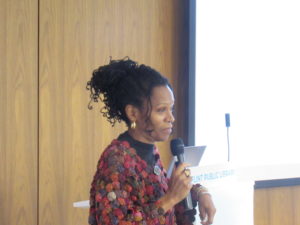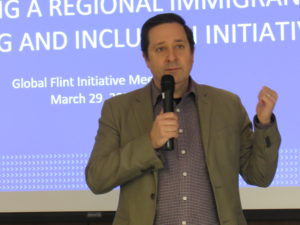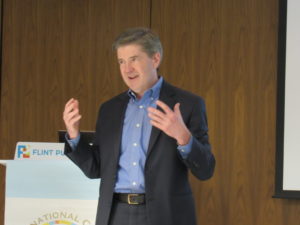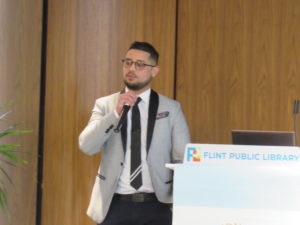By Harold C. Ford
“This is the ultimate win-win.” –John Austin, Michigan Economic Center, March 29, 2023
The International Center of Greater Flint (ICGF) recently assembled about 40 people representing nearly 20 organizations at the Flint Public Library March 29 to promote immigration as an approach to growing the population and economy of the greater Flint community.

Moderator Phyllis Sykes. (Photo by Harold Ford)
Phyllis Sykes and Adil Mohammed, co-founders of ICGF were organizers of the event, co-hosted by Greater Flint Health Coalition. Sykes was moderator.![]()
![]() “The increase in (Flint’s) international population (and) a gap in services here in Genesee County,” inspired the event, Sykes said. “We would like to hear what other communities are doing.” She called for a “needs assessment and strategic plan.”
“The increase in (Flint’s) international population (and) a gap in services here in Genesee County,” inspired the event, Sykes said. “We would like to hear what other communities are doing.” She called for a “needs assessment and strategic plan.”![]()

Attendees from the Flint area included: Freelon Threlkeld, pastor, Faith Baptist Temple; Raquel Thueme, president, Ruth Mott Foundation; Deba Dutta, chancellor, University of Michigan-Flint; Asa Zuccaro, director, Flint’s Latinx Center; Costa Papista, president, Flint City Bucks soccer organization; Dylan Luna, treasurer, Flint Board of Education; and representatives from Mott Community College, Genesee County Land Bank, United Way of Genesee County, Genesee County Health Department, and Flint Jewish Federation.
Also attending were: representatives from the offices of U.S. Senator Gary Peters and Michigan Governor Gretchen Whitmer; and Michigan Works! Association. Several members of the media, including East Village Magazine (EVM), were also present.
“Immigrant-welcoming strategies”
“Our community continues to experience population decline,” said Jim Ananich, former 27th district state senator from Flint, in a taped message. Deleterious effects of population loss include a declining tax base, deteriorating infrastructure, dwindling school population, and fewer congressional seats, he pointed out.
Ananich lauded the success of Global Detroit and its “success of immigrant-welcoming strategies implemented in the City of Detroit … and how they have successfully fostered new business, job and population growth, and community revitalization and development.”
Global Detroit
Three featured speakers at the March 29 event from Global Detroit – Steve Tobocman, executive director; Alaina Jackson, managing director; and Emma Davis, program manager – shared stories of challenges, strategies, and success.
Tobocman, Jackson, and Davis all touted the possible benefits of immigration:
- Tobocman: Immigration was a “stabilizing factor in (Detroit) neighborhoods … We found undeniable benefits in these (immigrant) communities that accrue to everyone in the community.”
- Jackson: Tangential benefits of immigration included: a decrease in commercial property vacancy rates; the growth of local microeconomies with increased business startups and employment; increased safety and decreased crime rates; increased home ownership and fewer landlord-tenant properties; improved conditions of homes and commercial properties; and declining tax delinquencies and foreclosures. “When immigrants come to our city (Detroit), they start businesses and they hire people … from the neighborhood.”

Steve Tobocman of Global Detroit speaking at the March 29 event. (Photo by Harold Ford)
- Davis: Successful immigrant-welcoming initiatives need “the right people, at the right place, at the right time … 2023 is looking like that year” for Flint. Davis said she is hopeful that a $30 million package to support such initiatives will soon achieve final passage in Michigan’s state government. If approved, funds would be routed through the Office of Global Michigan to grassroots initiatives.
Population loss and population growth
Constant themes at the ICGF event were the consequences of Flint’s precipitous population loss in recent decades and, conversely, the benefits of future population growth.
Flint frequently finds itself a poster child for websites like that of World According to Briggs with posts such as “10 Fastest Dying Cities in the United States.”
Flint’s top spot on the Briggs list is supported by the nation’s decennial census which documents the Vehicle City’s shrinkage:
- 1980: -17.4 percent
- 1990: -11 percent
- 2000: -11 percent
- 2010 -18 percent
- 2020: -20.7 percent
From 2010 to 2020 Flint lost more than one-fifth of its population when it declined from 102,000 to 81,000.
John Austin, director of the Ann Arbor-based Michigan Economic Center, another featured speaker at the ICGF event, pitched population growth as a way of revitalizing communities in the midwestern United States:
“This is still the land of opportunity … where Flint looks awfully good for so many … particularly if they’re coming from countries where they’re not safe, where there’s no economic opportunity … Immigrants are a source of economic renewal … Immigrants come here and they start businesses and they put other people back to work … Immigrants have historically been professionals. They come and apply their talents to communities … It’s a very powerful strategy for embracing, as Flint once did, folks who come here seeking a better life.”

John Austin of the Michigan Economic Center speaking at the March 29 event. (Photo by Harold Ford)
Statistics from the Office of Global Michigan bear out Austin’s assertions:
- 84,000 Michiganders are employed by Latino and Asian-owned businesses;
- $11.6 billion in sales and receipts are generated by Latino and Asian-owned businesses;
- $544 million in state tax revenue is generated by Arab American each year.
“Immigrants account for all population growth (in Michigan) in the last 30 years,” Jackson added. “No major U.S. metropolitan area that has lost population since the 60s has been able to stabilize that population, reverse its course, without immigration.”
“I’m hopeful.”
“Institutional change is slow,” Zuccaro cautioned. “We see the discrimination that happens in our community. It’s difficult … It can be difficult to sleep at night.”

Asa Zuccaro of Flint’s Latinx Center. (Photo by Harold Ford)
“I wonder if some of our important institutions had representation from the immigrant community,” Zuccaro said. “I think that would drastically and rapidly change the pace at which our institutions address our systemic barriers that exist locally.”
“You can have a dream, an idea, but if you have no money, you have no mission,” Zuccaro continued. “It takes money to move this mission along.”
“I’m hopeful,” he concluded.
Immigrant population in Genesee County increases as overall population declines
Data from the American Community Survey as analyzed and summarized by the University of Michigan-Flint, estimates that Genesee County’s overall population declined by 1.6 percent, from 413,090 to 406,400, from 2012-2016 to 2017-2021. During that same period, the immigrant population in the county increased 12.9 percent, from 9,977 to 11,269.
In 2021, the top five countries of origin for immigrants into Genesee County included (country of origin, number of immigrants, percentage of total immigrant population): Canada, 969, 8.6 percent; India, 951, 8.4 percent; China, 816, 7.2 percent; Mexico, 663, 5.9 percent; Cuba, 567, 5 percent. At least 63.5 percent of these immigrants have become naturalized citizens.
*****
[Editor’s note: Through genealogical research, EVM writer Harold C. Ford discovered that he descended from a great-grandmother and grandmother who were illegal immigrants from French Canada in the late 1800s.] More information is available at this link in a story by Ford “Why I Love Flint”.
Banner photo source: ICGF Facebook page
EVM reporter can be reached at hcford1185@gmail.com.


You must be logged in to post a comment.